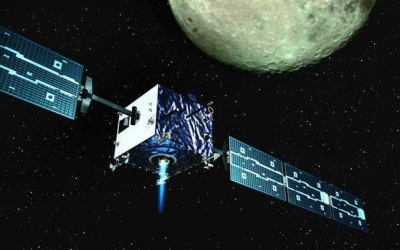
Launched on September 27, 2003, the lunar probe named SMART-1 was the European Space Agency’s (ESA) first mission to the moon. Apart from investigating the moon and studying its surface composition, the spacecraft was used to demonstrate techniques pertaining to navigation and mission control. A.S. Ganesh takes a look at the mission and its success
We might have over 200 natural satellites in the solar system, but our own moon is rather special to us. And it has to be, for it is the only one our Earth has. Naturally then, it has been studied extensively – probably only next to the Earth itself among celestial bodies.
While the space race between the U.S. and the Soviet Union in the second half of the 20th Century probably saw the most funds being spent in a single window towards moon missions, it wasn’t the be all and end all. There have been several missions since then, and there will be many more as well, that will have our moon as its target. Its position – both in terms of importance and in terms of space – make it an ideal destination for testing out new technologies as well.
Missions of all scales
The ESA prides itself in having a science programme that encompasses missions of all scales and sizes. The SMART – short for Small Missions for Advanced Research in Technology – programme was envisioned to cater to small relatively low-cast missions. One such mission that looked to test solar-electric propulsion and other deep space technologies was launched on September 27, 2003. Its destination, as you might have rightly guessed, was the moon.
With a French-built Hall effect thruster derived from a Russian ion propulsion system, SMART-1 was European in almost every sense, even before it became the first European spacecraft to enter orbit around the moon. The thruster, which used a xenon propellant, generated just enough thrust – comparable to the weight of a postcard. Solar arrays powered the engine which generated the power needed for the ion engines.
Slowly expanding orbit
Following its launch, it was put in a geostationary transfer orbit. From here, SMART-1 used its electric propulsion system for a hugely efficient mission profile. Spinning slowly, the spacecraft moved onto higher and higher elliptical orbits. With mission controllers in Darmstadt, Germany forcing calculated, repeated burns of the ion engine, the spacecraft’s spiral orbit expanded step by step.
When SMART-1 was around 2,00,000 km out from Earth, the influence of the moon’s gravity started increasing. By November 2004, the spacecraft had reached a point where the moon’s gravitational force was dominant.
Closer views, better data
The ion engines were still fired gradually, even after SMART-1 attained a polar orbit around the moon. This allowed the spacecraft to now decrease the orbit and hence achieve significantly better and closer views of the lunar surface.
During its time orbiting the moon, SMART-1 improved on data returned from various previous missions to the moon. It studied lunar topography, learnt more about the moon’s surface texture and also mapped the minerals’ surface distribution.
Mission extended
Even though the mission was designed to end in August 2005, it was extended further with new plans for a lunar impact in 2006. Having exhausted the propellant, the spacecraft’s ion engine was fired one last time in September 2005, after which it was in a natural orbit based on the gravitational effects of the moon, Earth and sun, with occasional altitude control. SMART-1’s ion engine had fired for over 4,900 hours, a record at that time for an engine of this type.
As per the revised plan, the spacecraft crashed onto the moon’s surface on September 3, 2006. Earth-based telescopes observed the impact, which produced a dust cloud. The near three-year existence of SMART-1 not only confirmed technical competence, but also provided valuable scientific insights about our moon.
Picture Credit : Google

